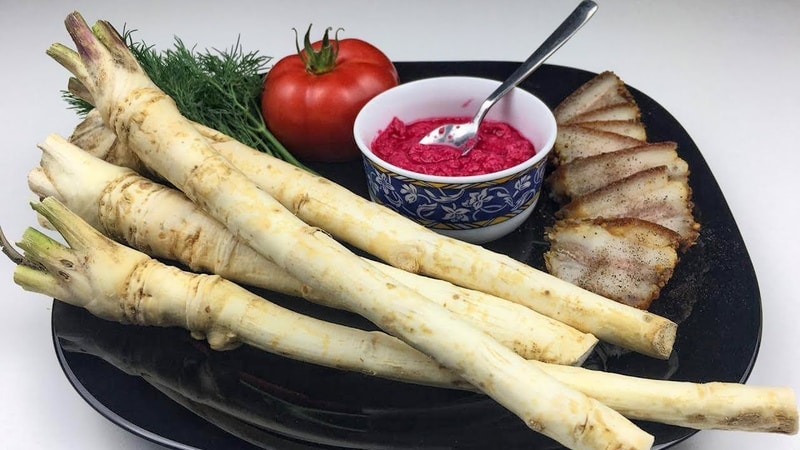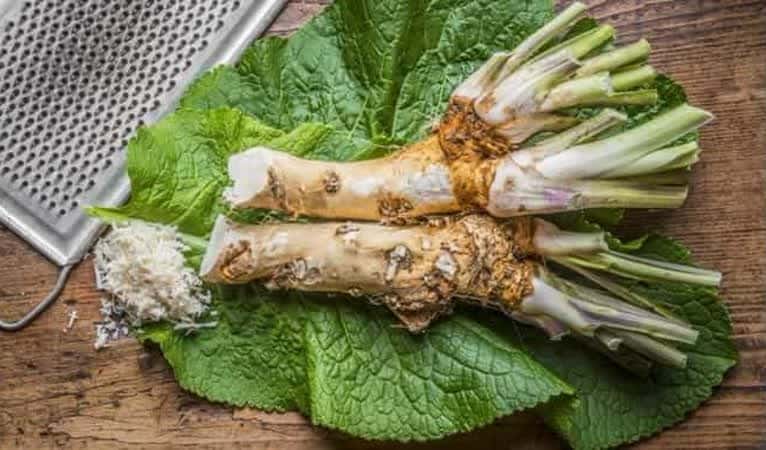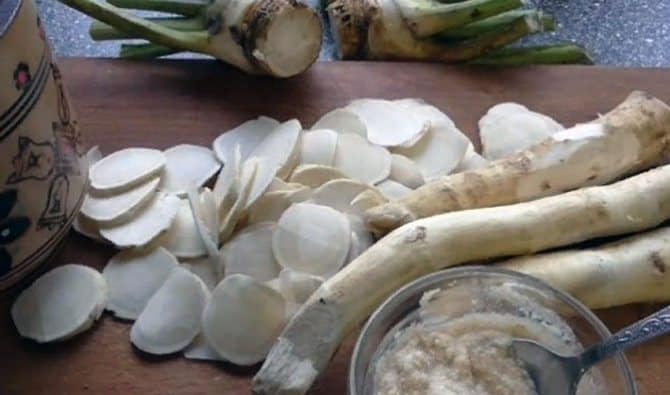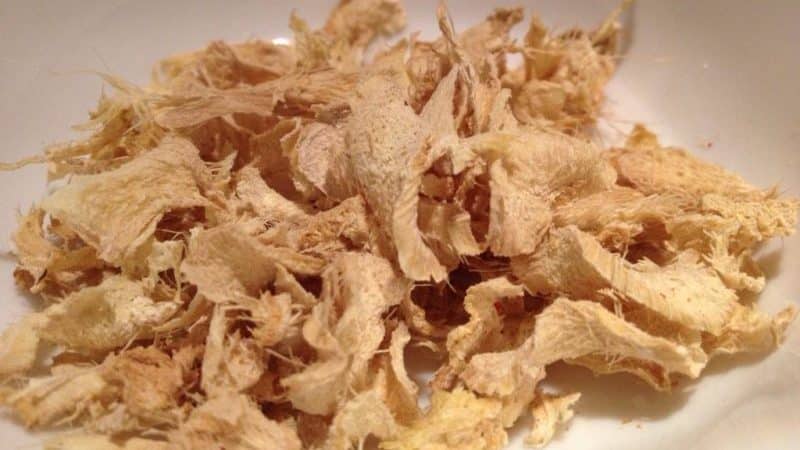How to properly prepare dried horseradish, store it and use it
Horseradish is used as a spicy, spicy seasoning for food and a medicine in folk medicine. There are different options for preparing the product: in the air, in the oven, in an electric dryer. Let's look at how to properly dry horseradish and where to use it.
What is good about dry horseradish?
Dried horseradish is almost as good as fresh horseradish in terms of nutritional content and taste, takes up little space in the kitchen cabinet and lasts a long time. stored.

Properties, nutritional value
The calorie content of horseradish is low - 56 kcal per 100 g. Energy value:
- proteins - 3.2 g;
- fats - 0.4 g;
- carbohydrates - 10.5 g.
Horseradish root is rich in vitamins and minerals:
- vitamin C - strengthens the immune system and blood vessels, participates in the synthesis of collagen and serotonin;
- B vitamins - support the functioning of the nervous system, participate in metabolic processes;
- silicon - important for strong bones, healthy teeth and beautiful nails;
- potassium - regulates water and acid balances, important for the conduction of nerve impulses;
- calcium - normalizes the functioning of the nervous system, strengthens bones, and participates in muscle contraction.
The roots contain a lot of magnesium, sodium, sulfur, phosphorus, iron, manganese, molybdenum, and zinc. Omega-3 and 6 fatty acids strengthen the cardiovascular system, reduce inflammatory reactions, and normalize blood cholesterol levels.
Essential mustard oils give horseradish a specific “burning” taste and smell and improve digestion.
Reference! The leaves contain up to 0.35% vitamin C, carotene and alkaloids.
Horseradish has antibacterial properties, as it contains phytoncides that destroy pathogenic microorganisms, protecting the body from infectious diseases.
The enzyme peroxidase promotes the breakdown of cancer cells, which is important for the prevention of malignant tumors.
The roots and leaves of the plant have beneficial properties, but in different proportions, which determines their use in certain cases.
Advantages and disadvantages of this harvesting method
By drying and then grinding horseradish roots, a concentrated product is obtained in powder form.

Pros:
- most of the beneficial properties and aroma are preserved;
- does not require a lot of space or special conditions for storage;
- long shelf life (up to 2 years).
However, during processing, some essential oils and phytoncides evaporate. As a result, the “hotness” of horseradish decreases, the smell becomes less pungent, and the medicinal properties are reduced.
Drying takes more time and money (increasing gas or electricity costs).
Selection and preparation of horseradish for drying

Both horseradish leaves and its roots are dried. Leaves are harvested in the summer, selecting green, juicy specimens without pests. Thick petioles are cut out of them. If the leaves are very dirty, they are washed under cold water and dried thoroughly.
The roots are collected in the fall, in October-November, in dry weather. Carefully dig up the rhizomes and cut off the old foliage.
Important! The roots should have a solid structure and a rich smell. Sluggish specimens with deep cracks, damage, and stains indicate old roots or improper storage (if purchased). It is better not to use such rhizomes, since most of the beneficial substances in them have already disappeared.
Rotten or damaged roots are thrown away. The rest are cleared of soil, small shoots and damaged parts are cut off, everything is quickly washed with cold water so that the roots do not have time to become saturated with excess moisture, and the top layer of skin is thinly cut off. The roots are slightly dried and ventilated in fresh air away from sunlight.
The caustic volatile compounds that horseradish produces can cause skin and eye irritation, so it is recommended that you wear protective gloves, goggles, and a mask when cleaning and chopping.
How to dry horseradish correctly
It is better to dry the leaves outdoors, in the shade, and for the roots there are several ways to prepare them. The choice depends on the drying location and the availability of kitchen appliances.

On air
To do this, use a slightly darkened room with low air humidity (no more than 50%), where direct sunlight does not penetrate and where regular ventilation is possible.
Suitable for this:
- shed or shed;
- balcony, loggia, veranda;
- a separate room in a house or apartment (this is an extreme option, since the sharp aroma of horseradish will spread throughout the room, which will permeate all the clothes).
Using a sharp knife, cut the roots into thin circles, strips or small cubes, and lightly chop the leaves. Lay everything out on clean sheets of paper and leave it in the chosen place for 8–10 days.
Attention! When drying leaves, the ambient temperature should not be higher than +40°C to preserve the essential oils.
Procurement time depends on:
- temperature and humidity in the room (the lower the first and higher the second, the longer the horseradish will dry);
- the size and thickness of the cut slices of root or leaves (the smaller and thinner they are, the faster they dry);
- availability of ventilation and proper air circulation in the room.
To ensure uniform evaporation of moisture, the product is periodically turned over. Thin roots are not cut, but tied together so that air can circulate freely between them, and in this form they are hung to dry. The same is done with small leaves, having first strung them on a strong thread.
In the oven
For drying in the oven, set the temperature to +40...+45˚C. Place the prepared plant roots (peeled, washed and thinly sliced) on a wide baking sheet covered with parchment paper. Dry the plant for about 2 hours.
To prevent the horseradish from being baked and dried, the oven door should be half open. After this, the device is turned off for 1 hour, but the roots are not removed, but dried for another 2 hours. In 2-3 approaches, the roots will dry to perfect condition.
Preliminary grinding of the roots will reduce the drying time by about 2 times. To do this, use a food processor, meat grinder, juicer or blender. The power of the device must be at least 700 W, otherwise it will not cope with the solid structure of the plant.
In an electric dryer
Using an electric dryer speeds up the workpiece by circulating hot air. The pieces will not brown, as can happen in the oven. The working and resting times of the device alternate:
- The chopped horseradish is placed on baking sheets without covering the openings for the movement of hot air.
- Close the dryer.
- Set the temperature to +40…+45˚C.
- After 2–2.5 hours the device is turned off.
- Rearrange the baking sheets: the bottom ones are up, and the top ones are down (this will allow drying to take place more evenly).
- Close the electric dryer and leave for 1.5 hours.
- Turn it on again at the same temperature for 2–2.5 hours.
Repeat the steps until the desired result is obtained.
How to check readiness

Properly dried root slices should be hard and brittle, and the crushed particles should be brittle. After preparation, the product is cooled and ground in a coffee grinder or ground with a mortar. Leaves are stored whole or in small pieces.
Terms and conditions of storage of dried horseradish
Horseradish powder, pieces or leaves are stored at room temperature in glass, tightly closed jars. The shelf life of roots is up to 2 years, leaves - up to 1 year.
This method preserves most of the nutrients and flavor. The smell of dried horseradish remains, but not as intense as that of fresh horseradish. This is what attracts many housewives to the seasoning.
Where and how to use the spice
For lovers of spicy food, horseradish takes pride of place. Not a single holiday table is complete without it. The plant strengthens the immune system, reduces inflammation, and destroys pathogenic microorganisms, so it is regularly consumed in small quantities and is actively used for medicinal purposes.
Use in cooking
The dried root is used in the preparation of various seasonings, marinades and sauces. To do this, pour the powder with warm boiled water or other liquid and leave until it swells for about 30 minutes. Then the remaining ingredients are added.
Crushed leaves are used mainly in canning vegetables: they enrich the taste of pickled, pickled and salted foods, preventing the formation of mold.
The unique aroma of the root is well revealed when cooking meat or fish. The use of horseradish in the preparation of kvass makes it “vigorous” and an excellent thirst quencher, and the strong horseradish tincture strengthens the fortitude and warms in small doses.
In folk medicine

Horseradish - a powerful natural antibiotic with an expectorant effect. His apply for colds, used in the form of decoctions, for inhalation, rinsing the mouth and throat.
Compresses made from root pulp reduce pain in the joints and lower back. Horseradish tincture has strong wound healing properties.
Horseradish quickly restores strength in case of overwork and vitamin deficiency. For diabetics it will help normalize blood sugar levels. Thanks to its diuretic effect, it helps cleanse the kidneys.
Regular consumption of horseradish improves male potency by normalizing blood circulation.
Face masks containing horseradish help get rid of acne. The active components of a natural antiseptic cleanse the skin and dry it, destroying bacteria.
The product is not recommended for use:
- in the presence of gastritis, ulcers and increased acidity of gastric juice;
- with kidney inflammation;
- for skin diseases;
- pregnant and lactating women.
Conclusion
This dry spice is a worthy alternative or addition to other horseradish preparation options. The roots and leaves are used for cooking and medicinal and prophylactic purposes. Dry outdoors, in the shade, in an oven or electric dryer at a temperature not exceeding +45˚C.